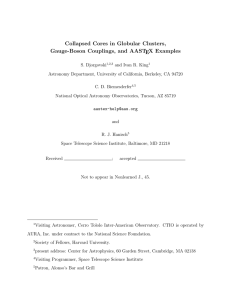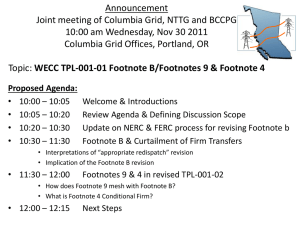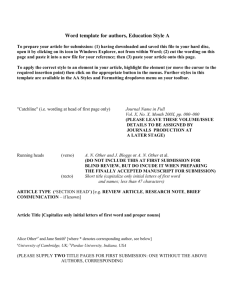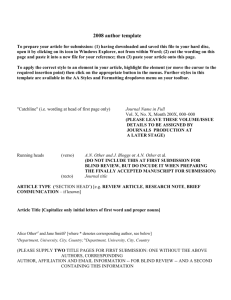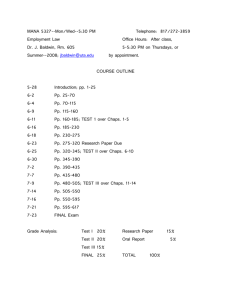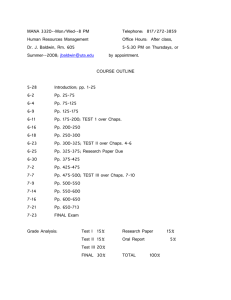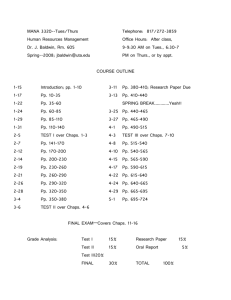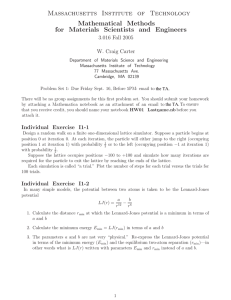Asymmetric Planetary Nebulae III ASP Conference Series, Vol. XXX, 2004
advertisement
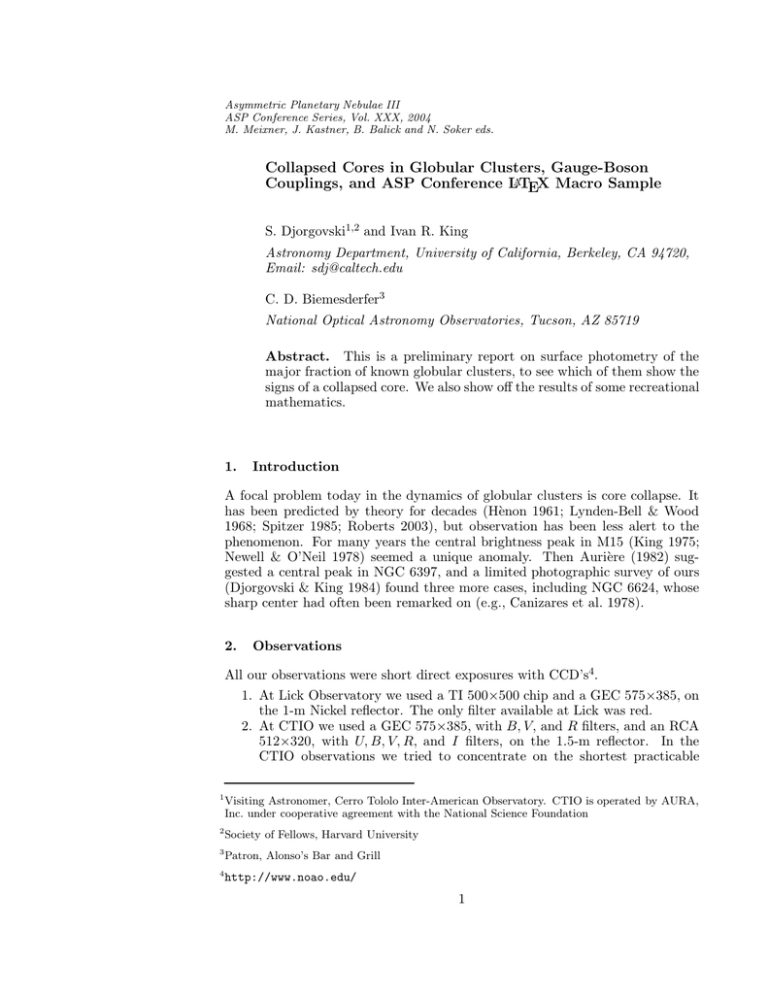
Asymmetric Planetary Nebulae III ASP Conference Series, Vol. XXX, 2004 M. Meixner, J. Kastner, B. Balick and N. Soker eds. Collapsed Cores in Globular Clusters, Gauge-Boson Couplings, and ASP Conference LATEX Macro Sample S. Djorgovski1,2 and Ivan R. King Astronomy Department, University of California, Berkeley, CA 94720, Email: sdj@caltech.edu C. D. Biemesderfer3 National Optical Astronomy Observatories, Tucson, AZ 85719 Abstract. This is a preliminary report on surface photometry of the major fraction of known globular clusters, to see which of them show the signs of a collapsed core. We also show off the results of some recreational mathematics. 1. Introduction A focal problem today in the dynamics of globular clusters is core collapse. It has been predicted by theory for decades (Hènon 1961; Lynden-Bell & Wood 1968; Spitzer 1985; Roberts 2003), but observation has been less alert to the phenomenon. For many years the central brightness peak in M15 (King 1975; Newell & O’Neil 1978) seemed a unique anomaly. Then Aurière (1982) suggested a central peak in NGC 6397, and a limited photographic survey of ours (Djorgovski & King 1984) found three more cases, including NGC 6624, whose sharp center had often been remarked on (e.g., Canizares et al. 1978). 2. Observations All our observations were short direct exposures with CCD’s4. 1. At Lick Observatory we used a TI 500×500 chip and a GEC 575×385, on the 1-m Nickel reflector. The only filter available at Lick was red. 2. At CTIO we used a GEC 575×385, with B, V, and R filters, and an RCA 512×320, with U, B, V, R, and I filters, on the 1.5-m reflector. In the CTIO observations we tried to concentrate on the shortest practicable 1 Visiting Astronomer, Cerro Tololo Inter-American Observatory. CTIO is operated by AURA, Inc. under cooperative agreement with the National Science Foundation 2 Society of Fellows, Harvard University 3 Patron, Alonso’s Bar and Grill 4 http://www.noao.edu/ 1 2 Djorgovski, King, & Biemesderfer wavelengths; but faintness, reddening, and poor short-wavelength sensitivity often kept us from observing in U or even in B. All four cameras had scales of the order of 0.4 arcsec/pixel, and our field sizes were around 3 arcmin. The CCD images are unfortunately not always suitable, for very poor clusters or for clusters with large cores. Since the latter are easily studied by other means, we augmented our own CCD profiles by collecting from the literature a number of star-count profiles (King et al. 1968; Peterson 1976; Ortolani et al. 1985) as well as photoelectric profiles (King 1966) and electronographic profiles (Kron et al. 1984). In a few cases we judged normality by eye estimates on one of the Sky Surveys. 3. Helicity Amplitudes It has been realized that helicity amplitudes provide a convenient means for Feynman-diagram evaluations. These amplitude-level techniques are particularly convenient for calculations involving many Feynman diagrams, where the usual trace techniques for the amplitude squared becomes unwieldy. Our calculations use the helicity techniques developed by other authors (Hagiwara & Zeppenfeld 1986); we briefly summarize below. 3.1. Formalism A tree-level amplitude in e+ e− collisions can be expressed in terms of fermion strings of the form v̄(p2, σ2)P−τ 6 a1 6 a2 · · · 6 an u(p1 , σ1) , (1) where p and σ label the initial e± four-momenta and helicities (σ = ±1), 6 ai = aµi γµ, and Pτ = 21 (1 + τ γ5) is a chirality projection operator (τ = ±1). The aµi may be formed from particle four-momenta, gauge-boson polarization vectors or fermion strings with an uncontracted Lorentz index associated with final-state fermions. Weyl spinors The Weyl spinors are given in terms of helicity eigenstates χλ (p) with λ = ±1 by u(p, λ)± = (E ± λ|p|)1/2χλ (p) , (2) v(p, λ)± = ±λ(E ∓ λ|p|) 4. 1/2 χ−λ (p) Floating Material and So Forth Consider a task that computes profile parameters for a modified Lorentzian of the form 1 (3) I= P (1+d2 ) 1 + d1 3 Collapsed Cores in Globular Clusters where d1 = d2 = r r x1 Rmaj 2 + y1 Rmin x1 P Rmaj 2 + y1 P Rmin 2 2 x1 = (x − x0 ) cos Θ + (y − y0 ) sin Θ y1 = −(x − x0) sin Θ + (y − y0 ) cos Θ In these expressions x0,y0 is the star center, and Θ is the angle with the x axis. Results of this task are shown in Table 1. It is not clear how these sorts of analyses may affect determination of M and M⊕ , but the assumption is that the alternate results should be less than 90◦ out of phase with previous values. • We should see that enumerated lists work as expected, with proper margins and indentation. The list that appears at the beginning of the paper is enumerated. • We should see that itemized lists work as expected, with proper margins and indentation. This list is itemized. Table 1. Terribly relevant tabular information. Star Height dx dy n χ2 1 2 3 4 5 6 33472.5 27802.4 29210.6 32733.8 9607.4 31638.6 −0.1 −0.3 0.9 −1.2 −0.4 1.6 0.4 −0.2 0.3 −0.5 −0.4 0.1 53 60 60 41 60 39 27.4 3.7 3.4 54.8 1.4 315.2 a 1.940 1.510 1.551 2.156 1.574 3.075 Pa 3.900 2.156 2.159 4.313 2.343 7.488 P Rmaj 68.3 6.8 6.7 117.4 8.0 92.1 P Rmin 116.2 7.5 7.3 78.2 8.9 25.3 Sample footnote for Table 1 b Another sample footnote for Table 1 c Footnote with no call out d e Rmin Another footnote with no call out A further additional footnote with no call out This paragraph has been placed here so that we can show the relationship between floating elements and running text. A sample figure appears in Figure 1. We insert the figure in the text file immediately after the sentence in which it is called out; this happens to be in the middle of a paragraph. Notice that this paragraph continues on after the figure environment is closed. The typeset text of the paragraph will not be broken by the figure; rather, the figure will be “floated” to an appropriate spot (top of page, bottom of page, possibly after the Θb −27.639 −26.764 −40.272 −35.847 −33.417 −12.052 4 Djorgovski, King, & Biemesderfer Figure 1. A particularly ghostly figure. paragraph) close to the textual material in which it is embedded in the source file. We repeat Table 1 which was formatted using the deluxetable environment, but this time we use the LATEX table environment (see Table 2). Either table environment is acceptable, but the deluxetable environment is preferred. Table 2. Star 1 2 3 4 5 6 Height 33472.5 27802.4 29210.6 32733.8 9607.4 31638.6 Terribly relevant tabular information. dx −0.1 −0.3 0.9 −1.2 −0.4 1.6 dy 0.4 −0.2 0.3 −0.5 −0.4 0.1 n 53 60 60 41 60 39 χ2 27.4 3.7 3.4 54.8 1.4 315.2 Rmin 1.940 1.510 1.551 2.156 1.574 3.075 Pa 3.900 2.156 2.159 4.313 2.343 7.488 P Rmaj 68.3 6.8 6.7 117.4 8.0 92.1 P Rmin 116.2 7.5 7.3 78.2 8.9 25.3 Θb −27.639 −26.764 −40.272 −35.847 −33.417 −12.052 a Sample footnote for Table 2 Another sample footnote for Table 2 c Footnote with no call out d Another footnote with no call out e A further additional footnote with no call out b However, reducing the text size does sacrifice the readability of the numbers in the table, and the table environment does allow more control over the spacing of the columns. The data table is shown a third time (Table 3) at normal size, using all of the LATEX tricks for eliminating space at the end of each row, controlling the space between columns, and controling the vertical space around the horizontal rules. In each table, note the use of the math mode minus sign ($-$) instead of the text mode dash. 5 Collapsed Cores in Globular Clusters Table 3. Star Height 1 2 3 4 5 6 33472.5 27802.4 29210.6 32733.8 9607.4 31638.6 Terribly relevant tabular information. dx dy n χ2 Rmin −0.1 0.4 53 27.4 −0.3 −0.2 60 3.7 0.9 0.3 60 3.4 −1.2 −0.5 41 54.8 −0.4 −0.4 60 1.4 1.6 0.1 39 315.2 1.940 1.510 1.551 2.156 1.574 3.075 Pa 3.900 2.156 2.159 4.313 2.343 7.488 P Rmaj P Rmin 68.3 6.8 6.7 117.4 8.0 92.1 116.2 7.5 7.3 78.2 8.9 25.3 Θb −27.639 −26.764 −40.272 −35.847 −33.417 −12.052 Acknowledgments. We are grateful to V. Barger, T. Han, and R. J. N. Phillips for doing the math in section 3.1. of this paper. References Canizares, C. R., Grindlay, J. E., Hiltner, W. A., Liller, W., & McClintock, J. E. 1978, ApJ, 224, 39 Djorgovski, S., & King, I. R. 1984, ApJ, 277, L49 Hagiwara, K., & Zeppenfeld, D. 1986, Nucl.Phys., 274, 1 Hénon, M. 1961, Ann.d’Ap., 24, 369 King, I. R. 1966, AJ, 71, 276 King, I. R. 1975, in Dynamics of Stellar Systems, ed. A. Hayli (Dordrecht: Reidel), 99 King, I. R., Hedemann, E., Hodge, S M., & White, R. E. 1968, AJ, 73, 456 Kron, G. E., Hewitt, A. V., & Wasserman, L. H. 1984, PASP, 96, 198 Lynden-Bell, D., & Wood, R. 1968, MNRAS, 138, 495 Newell, E. B., & O’Neil, E. J. 1978, ApJS, 37, 27 Ortolani, S., Rosino, L., & Sandage, A. 1985, AJ, 90, 473 Peterson, C. J. 1976, AJ, 81, 617 Spitzer, L. 1985, in Dynamics of Star Clusters, ed. J. Goodman & P. Hut (Dordrecht: Reidel), 109
